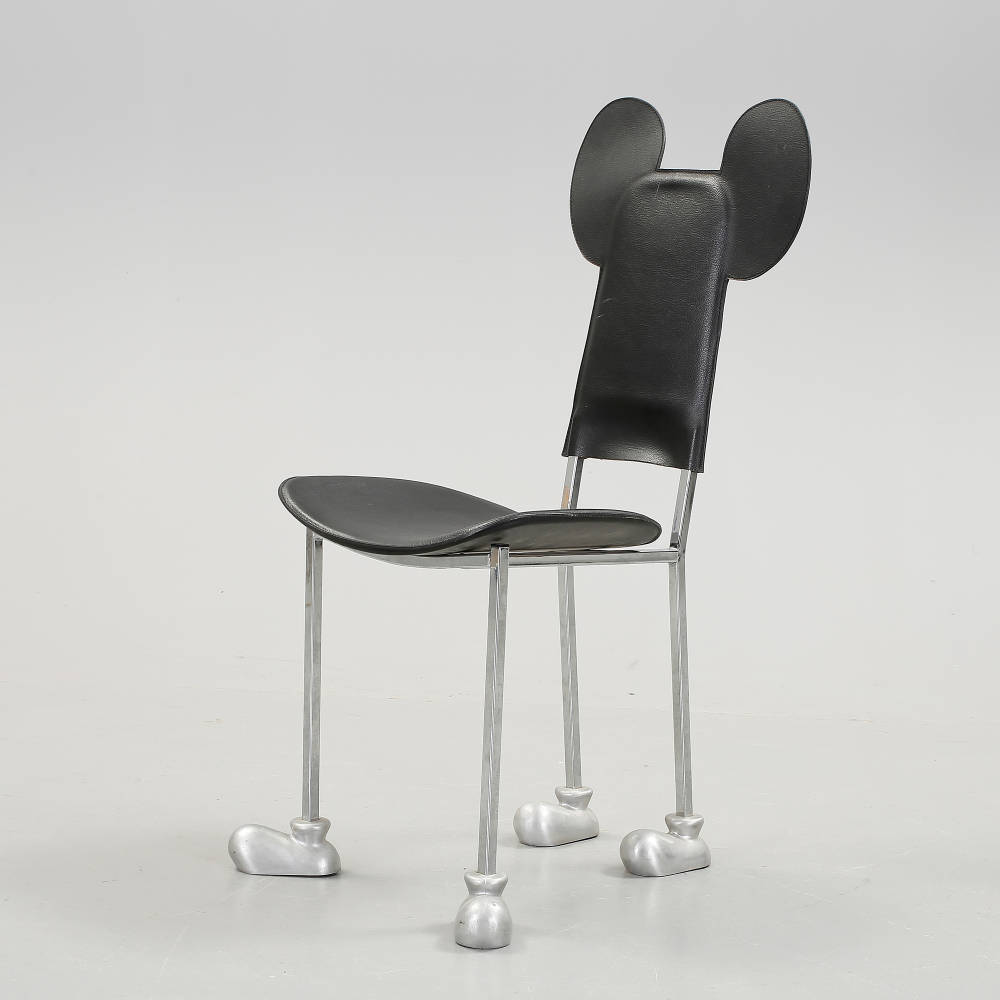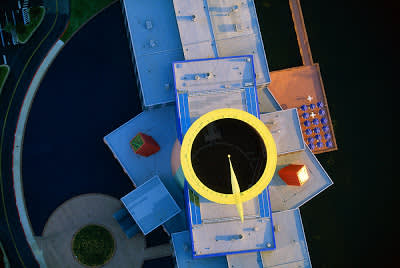
Robert D. Feild
The Art of Walt Disney
Mickey Mouse first debuted in 1928, with an 8-minute film called ‘Steamboat Willie,’ the first Disney project to utilize synchronized sound. While the new sound technique captivated audiences, it was the film’s lovable main character that truly stole hearts. Mickey and his fixed world of anthropomorphic animals and objects became an instant sensation, quickly becoming the official mascot of the Walt Disney Company. The world of Mickey Mouse acted as a welcomed distraction from the heated international conflicts that arose throughout the subsequent decades. Somewhat inspired by silent film star Charlie Chaplin, Mickey’s positive attitude and unique ability to ignite cheer made him an enduring image for a hopeful future. Today, Mickey Mouse is an internationally recognized symbol, plastered across animated films, theme park rides, ships, shops, and merchandise worldwide, as well as fine art, architecture and high fashion.
The king of the commercial art world, Andy Warhol, created an array of prints, sketches, and drawings throughout his career honoring the iconic Mickey Mouse. It makes sense that Warhol would gravitate towards a symbol that — quite literally — illustrates the merging of art and the commercial world. In his 1981 “Myths” series, Warhol created screen prints of iconic pop culture figures from 1950s television and old Hollywood films. Mickey, of course, shows up prominently in several prints and paintings throughout this body of work. Similarly, in 1961 American pop artist Roy Lichtenstein created a work titled ‘Look Mickey,’ demonstrating the first time Lichtenstein directly appropriated an existing pop culture image in his oeuvre. Yet the original graphic, borrowed from the children’s book ‘Donald Duck: Lost and Found,’ was delicately amended by Lichtenstein’s trademark style, primary color palette, and choosy omissions. Unsurprisingly, this wasn’t first time the artist flirted with the use of Mickey Mouse caricatures in his work, a 1958 pastel sketch renders an abstract image of Mickey transposed in movement.

Andy Warhol
Mickey Mouse, 1981

Andy Warhol
Mickey Mouse, 1981

Andy Warhol
Mickey Mouse, 1981

Donald Duck Lost and Found
1960

Roy Lichtenstein
At his 26th Street Studio, NYC, 1964

Roy Lichtenstein
Look Mickey, 1961

Roy Lichtenstein
Mickey Mouse I, 1958
Like Lichtenstein’s sketch, other artists have taken to more loose interpretations of the Mickey Mouse motif, further demonstrating the enduring legacy of the image: even manipulated into various versions of itself, the symbol of Mickey Mouse is always recognizable. One artist whose work perfectly embodies this phenomenon is sculptor Claes Oldenburg, who has returned to the mouse theme numerous times throughout his career, the symbol becoming as attached to Oldenburg as the lobster is to Salvador Dali. The artist addressed this with a simple statement, remarking, “I am the Mouse.” The first appearance of Mickey Mouse in Oldenburg’s work was in a nefarious-looking sketch form on a 1963 poster promoting the artist’s show at Dwan Gallery, while numerous notebook pages throughout his career show various sketches of the mouse symbol. In 1970s Oldenburg’s geometric mouse figure escalated further, culminating in the Mouse Museum, an exhibit installation shaped in the geometric form of Mickey Mouse, for which Oldenburg became well known. Inside the exhibit were 400 colorful objects, knick-knacks, and memorabilia, arranged in vivid stories and visual puns.

Claes Oldenburg
Notes (Micky Mouse), 1968

Claes Oldenburg
Dwan Gallery, Poster, 1963

Claes Oldenburg
Geometric Mouse, Scale E Desktop, 2013

Claes Oldenburg
Mouse Head Variations, Notebook Page, 1966

Claes Oldenburg
Rendering, Mouse Museum

Claes Oldenburg
Mouse Museum

Claes Oldenburg
Mouse Museum
Some artists have collaborated directly with Disney to create representations of the iconic mouse. In 2012, at the invitation of The Walt Disney Company, Damien Hirst created “Mickey,” to be auctioned at Christie’s London as aid for the Kids Company. The painting, made entirely of colored circles – a figurative interpretation of the artist’s iconic dot paintings – shows the whimsical spirit of both Hirst’s work and Mickey Mouse as a representation for all of Disney. Hirst went on to create more images of Mickey, including a 2013 spin painting titled “Beautiful Mickey,” as well as “Mickey” and “Minnie” in 2016, which were new versions of his 2012 image, updated with glitter. Most recently, Hirst’s 2017 “Treasures from the Wreck of the Unbelievable” show featured a bronze statue of Mickey Mouse covered in coral that appeared to have been “rescued” from the bottom of the sea. Other artists who have used the Mickey Mouse symbol as a subject in their work include Wayne Thiebaud, Peter Max, and Romero Britto.
Damien Hirst
Mickey, 2012
Damien Hirst
Mickey, 2016
Damien Hirst
Minnie, 2016
Damien Hirst
Beautiful Mickey, 2015
Damien Hirst
Mickey, 2017
Wayne Thiebaud
Yellow Mickey Mouse Cake, 1998
Wayne Thiebaud
Toy Mickey, 1988
Peter Max
Mickey Mouse
Peter Max
Mickey Mouse Suite of 4 Serigraphs, 1995
Romero Britto
Mickey Mouse
Similarly, artist Brian Donnelly, better known by his street name ‘KAWS,’ took inspiration from Disney and the Mouse motif for a series of iconic works honoring the fictional character. In fact, Donnelly was an animator at Disney in the early years of his career, before abandoning corporate culture and taking his art to the streets. KAWS’ work quickly became synonymous with his cast of cartoonish characters. Beyond Mickey’s iconic ears, many of the artist’s paintings depict figures outfitted in Mickey Mouse’s signature white gloves and trousers. Like Andy Warhol, KAWS merges the gap between art and commerce, spinning his creative web to also include toys, clothing, and merchandise.

KAWS
First Companion, 1999

KAWS with Sculpture Companions, 2016

KAWS
KAWS Companions, 2016

KAWS
The KAWS Album, 2005

KAWS
KAWS x Calvin Klein Christy Turlington Ad 1990s
The status of Mickey Mouse as an iconic and enduring image throughout popular culture makes him the perfect motif to incorporate in modern fashion. The most obvious collaboration between fashion and Disney is in the world of branded merchandise. Creating products that combine the spirit of a brand with Mickey Mouse’s legendary image is a surefire way to sell. In 2016 Coach debuted their Mickey Mouse handbag; a bright, red leather cross body satchel whose silhouette mimicked Mickey’s instantly recognizable ears. Coach’s version of Disney merchandise was understated yet obvious, with sneaky tags adding illusions of Mickey’s eyes to the design. In a more traditional ode to the fictional character, Jeremy Scott’s Mickey Mouse collaboration from Fall/Winter 2009 featured a limited edition high-top sneaker with Mickey’s likeness as the shoe’s tongue. The growing demand and PR success of Jeremy Scott’s design made a direct collaboration with Disney an attractive proposition for even the most established brands.

Coach
Coach's 75th Anniversary Disney x Coach Collection, 2016

Jeremy Scott
Jeremy Scott x Adidas “Mickey Mouse” Fall 2009 Sneakers
One such example is Gucci, who celebrated the 90th birthday of Mickey Mouse with a Spring/Summer 2019 handbag honoring Disney’s token mascot. Since Alessandro Michele took the helm of the brand in 2015, the designer’s love for all things Disney has permeated numerous collections. As such, the Gucci x Walt Disney handbag, which begs comparison to a child’s lunchbox, used a 3-D render of Mickey’s face to form a bulbous shell into which the object’s wearer could stash their belongings, with the bag’s handle connecting his ears at the top. Some designers have gone so far as to incorporate the Mickey Mouse motif into entire collections. For Fall/Winter 2007, Comme des Garcons featured Mickey Mouse ear hats, superimposed baby dresses, Minnie Mouse bows and 3-dimensional glove decals. The collection focused on the development of the female psyche and, as such, the role that Minnie Mouse plays in developing femininity in popular culture and the public conscience. Rei Kawakubo cleverly examines the familiar children’s cartoon from a theoretical lens and allows her work to speak for itself.
Gucci
Walt Disney x Gucci, Spring/Summer 2019
Gucci
Cruise 2020
Comme des Garçons
Fall/Winter 2007
Comme des Garçons
Fall/Winter 2007
Comme des Garçons
Fall/Winter 2007
Comme des Garçons
Fall/Winter 2007
Similarly, Jean-Charles de Castelbajac incorporated his own sensibilities into his Spring/Summer 2012 Mickey Mouse collaboration. Castelbajac’s trademark tongue-and-cheek style is present in collection’s silhouettes, fabric choices and color scheme, combined with cartoony images of the show’s central character, he also created various pieces featuring Mickey Mouse motifs in the 1980s as well. Marc Jacobs has shown his appreciation for the whimsical world of Disney in past collections as well as through his numerous cartoon tattoos. For Spring/Summer 2013, Jacobs presented a mod collection honoring the 1960s, pairing a low-slung black skirt with a cropped logo sweater embroidered with a Mickey Mouse charactiture. Numerous other designers and brands have dipped their respective toes into the world of Mickey Mouse-branded merchandise, including Rag and Bone, Vans, Kate Spade, and even skate-wear brand Supreme. Perhaps it is Mickey Mouse’s everlasting power as a symbol of whimsy — or a symbol of corporate power — that draws designers to his image again and again.
Jean-Charles de Castelbajac
1986
Jean-Charles de Castelbajac
2002
Jean-Charles de Castelbajac
Spring/Summer 2012
Jean-Charles de Castelbajac
Spring/Summer 2012
Jean-Charles de Castelbajac
Spring/Summer 2012
Marc Jacobs
Spring/Summer 2013
Notwithstanding Mickey’s enduring star-power, there is also something to be said for the simplicity of the character’s design: three combined circles instantly become his head and ears, now a universally recognized symbol of happiness. As such, it is no surprise that individuals working in the fields of graphic and industrial design would also choose to reference Mickey in their work. Garriris von Mariscal’s “Mickey Mouse Chair” combines the artist’s background in illustration and love for cartoons with his crafting skills as a furniture designer. The simple black chair features two circular ‘ears’ emerging from the back, as well as cartoonish metal shoes fitted to each of the chair’s four legs. The Italian furniture company Cappellini collaborated with Walt Disney on the “Mickey Mouse Ribbon Stool,” a red stool with a back made of the aforementioned three circles that form Mickey head and ears. The legs of the stool resemble looped ribbons, curving in a whimsical manner that screams Disney. Perhaps most notably, designer Ettore Sottsass reimaged Mickey Mouse through an abstract lens for a 1971 series of furniture. Inspired by the cartoon’s simple design, Sottsass’s table and chairs set combines bright colors with half-bubbles that hold the legs of the table and stool.

Garriris von Mariscal
Mickey Mouse Chair

Garriris von Mariscal
Mickey Mouse Chair

Cappellini and Walt Disney
Mickey Mouse Ribbon Stool

Cappellini and Walt Disney
Mickey Mouse Ribbon Stool

Cappellini and Walt Disney
Mickey Mouse Ribbon Stool

Ettore Sottsass
Micky Mouse Table, 1971

Ettore Sottsass
Micky Mouse Table, 1971
Given Disney’s international presence, the company’s most iconic motif has of course inspired architecture throughout their many parks and headquarters. Disney’s administrative center in Florida, built by Japanese architect Arata Isozaki, is a primary example. Built in 1990, the buildings eclectic, post-modern style is a playful rendering of the Disney spirit onto a physical structure. The Disney Building is composed mostly of cubic wings skewed at contrasting angles in an array of bright colors and patterns finishes, while grids of reflective glass decorate the outside. The focal point, a conical tower that hosts a sundial inside, resembles a futuristic UFO landing platform. The building is harmoniously balanced despite its busy facade, and Mickey Mouse ears appear abstracted as an entrance canopy.

Arata Isozaki
The Disney Building, 1990

Arata Isozaki
The Disney Building, 1990

Arata Isozaki
The Disney Building, 1990

Arata Isozaki
The Disney Building, 1990

Arata Isozaki
The Disney Building, 1990

Arata Isozaki
The Disney Building, 1990

Arata Isozaki
The Disney Building, 1990
A short drive away is another “hidden Mickey”. Disney World’s solar facility, a 22-acre solar farm, when seen from a bird’s eye view is instantly recognizable as Mickey Mouse. Consisting of over 500,000 solar panels, the farm provides solar power to Disney World as part of an initiative to make Disney’s Florida parks more energy efficient. In less than a hundred years, the simple design of a cartoon mouse has spawned a legacy that permeates nearly every aspect of modern-day culture. Mickey Mouse has become an iconic image, recreated, remodeled, and manipulated throughout the decades. From an illustration to a symbolic motif, the enduring power of simple lines on paper will forever be remembered in Mickey Mouse

Disney
Solar Farm



